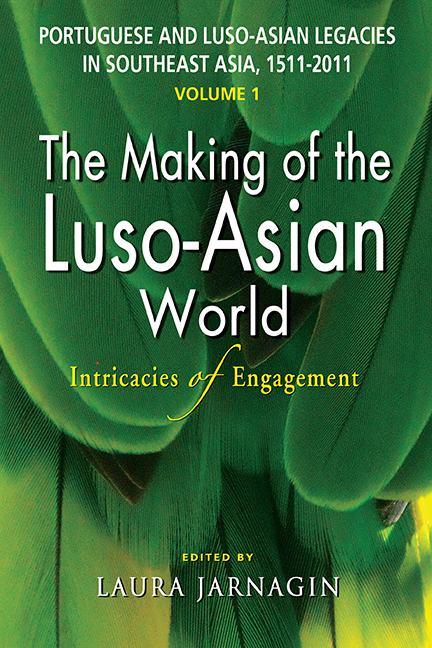 Portuguese and Luso-Asian Legacies in Southeast Asia, 1511–2011, vol. 1
Portuguese and Luso-Asian Legacies in Southeast Asia, 1511–2011, vol. 1 Book contents
- Frontmatter
- Contents
- List of Charts, Figures and Tables
- A Tribute to Glenn Ames
- Preface
- List of Contributors
- Glossary
- Introduction: Towards Clarity through Complexity
- Part One Adaptations and Transitions in the South and Southeast Asian Theatres, Sixteenth through Eighteenth Centuries
- Part Two Dispersion, Mobility and Demography from the Sixteenth into the Twenty-first Centuries
- 6 The Luso-Asians and Other Eurasians: Their Domestic and Diasporic Identities
- 7 The Population of the Portuguese Estado da Índia, 1750–1820: Sources and Demographic Trends
- 8 Flying with the Papagaio Verde (Green Parrot): An Indo-Portuguese Folkloric Motif in South and Southeast Asia
- Part Three Mixed Legacies: The Portuguese and Luso-Asians in the Twentieth and Twenty-first Centuries
- Bibliography
- Index
6 - The Luso-Asians and Other Eurasians: Their Domestic and Diasporic Identities
from Part Two - Dispersion, Mobility and Demography from the Sixteenth into the Twenty-first Centuries
Published online by Cambridge University Press: 21 October 2015
- Frontmatter
- Contents
- List of Charts, Figures and Tables
- A Tribute to Glenn Ames
- Preface
- List of Contributors
- Glossary
- Introduction: Towards Clarity through Complexity
- Part One Adaptations and Transitions in the South and Southeast Asian Theatres, Sixteenth through Eighteenth Centuries
- Part Two Dispersion, Mobility and Demography from the Sixteenth into the Twenty-first Centuries
- 6 The Luso-Asians and Other Eurasians: Their Domestic and Diasporic Identities
- 7 The Population of the Portuguese Estado da Índia, 1750–1820: Sources and Demographic Trends
- 8 Flying with the Papagaio Verde (Green Parrot): An Indo-Portuguese Folkloric Motif in South and Southeast Asia
- Part Three Mixed Legacies: The Portuguese and Luso-Asians in the Twentieth and Twenty-first Centuries
- Bibliography
- Index
Summary
The Luso-Asians are the descendants of sixteenth- and seventeenth-century Portuguese colonists who cohabitated and intermarried with the various indigenous women of Asia: from Diu in India to Nagasaki in Japan; from Macao in China to East Timor in the Pacific. They are also the descendants of slaves belonging to the Portuguese settlers who, over the course of several centuries, merged into the Portuguese mixed-blood societies. These slaves originated from the coasts of India and Sri Lanka, the islands of the Indonesian archipelago, and, in lesser numbers, the Portuguese colonies in Africa. The Luso-Asians are part of the small communities of part-European people who played a significant role in the power politics of colonial Asia. Playing the part of cultural brokers in a complicated relationship between the European administrators and the indigenous peoples, their Western education enabled them to hold posts in government and the professions; they were paid more than other locals, but less than the Europeans. These hybrid groups, who generally comprised 1 to 2 per cent of their national populations, had various local names and identities but have come to be known collectively as Eurasians. The Luso-Asians were the first Eurasians. The non-Luso-Eurasian communities developed later and include the Dutch Burghers of Sri Lanka, the Indo-Dutch of Indonesia, the Anglo-Indians of India, the Anglo-Burmans of Myanmar and other Anglo communities in Sri Lanka, Malaysia/Singapore and Hong Kong.
This chapter examines the fifteen Eurasian communities which emerged during the colonial era. It focuses on their formation, their diverse ancestral combinations and their evolution during the three colonizing periods of the Portuguese, Dutch and British. The original Luso-Asian groups are the Luso-Indians of India, the Portuguese Burghers of Sri Lanka, the Kristang of Malacca in Malaysia, the Macanese of Macao in China, the Larantuqueiros of the Nusa Tenggara province in Indonesia and the Mestizos of East Timor. All these communities originated between 1510 and 1558. On this quincentennial anniversary of Portuguese settlement in the East, we also acknowledge the communities which were very much part of these golden years of the Portuguese “empire”, communities which have since been absorbed by other larger ethnicities. These lost communities include the Bayingyis of Myanmar; the Luso-Siamese of Thailand; the mestizos of the Spice Islands, Indonesia; and the Batavian Portuguese and Mardijkers of Indonesia.
- Type
- Chapter
- Information
- Portuguese and Luso-Asian Legacies in Southeast Asia, 1511–2011, vol. 1The Making of the Luso-Asian World: Intricacies of Engagement, pp. 131 - 154Publisher: ISEAS–Yusof Ishak InstitutePrint publication year: 2011
